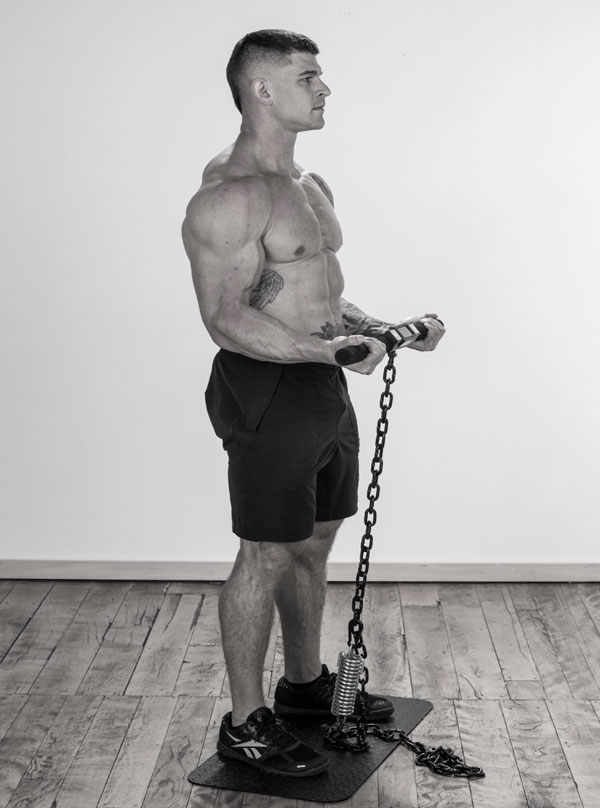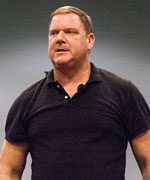How to Work on Your Weaknesses and Build Sustained Strength
By Dan John
I've been in the weightroom a long time. I've done the dumb stuff...workouts until I puked, Internet challenges, the machine-based stuff and lots of other idiocy. You might think, if you read my journals (basically daily since 1971) that I am clueless when it comes to training.
You might be right.
Really. You might be right.
I have a standard joke: it worked so well, I stopped doing it. I can walk you through reams of paper where I finally figured things out and got "better." I cut down volume in some areas and allowed myself to grow. I learned how to hinge properly. I discovered the importance of pull ups, hill sprints and loaded carries.
And… "Squirrel!!!"
I bounded off and soon found myself again full of ticks and brambles and muddy clothes.
I’ve let a lot of great ideas slide past me because of Exercise ADD and the general fear of "missing out."
Missing out. If there is a curse on the road to greatness it is the fear of missing out.
Some things have worked so well that I literally haven’t trusted the results. I pass the results off to simply the normal learning curve or changing anything makes things better. Like when Dave Turner FORCED me to do squats off a 34 inch set of saw horses and I went from barely getting 135 pounds to 365 pounds on this movement is six weeks. This "Dead Stop" program was a return to one of my roots, my life long love affair with isometrics.
It worked so well, I stopped doing it.
One thing I could never get around explaining was isometrics. Functional Isometric Training, the old rack pin lifting, made me strong enough to rip trees up from the ground for caber tossing. Isometric holds taught me how to not only improve my own technique but improve the techniques of others.
Honestly, some of these drills worked instantly. It’s a powerful tool. When my
Isochain turned up at my house, I was interested in seeing what I could learn. For once, I did an unusual thing for me:
I read the instructions;
I read the manual.
Knowledge can often ease the passage.
Obviously, I usually skip the obvious!
I took on John Du Cane’s challenge of doing a very simple one-month test. I performed only three moves three days a week:
The deadlift just above my knees.
The midpoint of the curl
The sticking point of the military press
This program is "The Promethean;" it calls for four to six reps of six seconds of holds three days a week. The rest period is twenty seconds and the workout takes very little time at all.
I learned a few things quickly with the
Isochain. Let’s talk some specific "fixes" before we move on. First, I wanted to test myself at the exact same spot daily. So, I pulled out a little dot of red paint and placed it on the inside of the three chain links that I would use each workout.
It’s pretty simple. The moment the paint dried, my wife said: "Why don’t you use those little clasps we use for wine glasses at our parties."
Yes. Yes, that is a better idea. Now I have a multi-colored
Isochain.
Next, I realized that setting the loads up and down is far easier with kilos than pounds. It’s only a few minutes difference but, when it comes to training, a few minutes here and there oddly add up. Maybe not for you but I like to "get in and get out!"
I quickly fell in love with two things. These two things are worth discussing in depth. First, let’s discuss "an issue" with me.
Now, I am a fairly nice man, I have a great head of hair and I am very punctual. I remain as always, as a world record holder once told me, "a mess of fast-twitch muscle fiber." I think that was a compliment.
And…that’s my problem. I can give a mighty whack to a discus, snap an Olympic barbell over my head and put my opponent on the ground with a shoulder tackle.
What I recently discovered on the
Isochain is that I have no lower gears. I use Load Mode (Mode Number Two) when I train. The
Isochain "beeps" when I hit my target. Here’s what I discovered at first:
Beep! I’m not sure how to type "silence," but that’s what I heard after the first beep. Nothing. The program called for six beeps!
It quickly became obvious that I am a One Beep Danny. I’m not proud of that. The goal was six beeps, I got one. An obvious question arises: where are those five beeps?
If there is one insight I learned with this
Isochain, my personal gamechanger, it was this: Where are those five beeps?

It took several sessions for me NOT to Olympic lift or ballistically HIT the force plate. I learned to both lighten the load (embarrassing me to no end) and sustain the beeps. Soon, I got the six beeps.
The beeps...oh, man...the beeps. I started living for those beeps, man. I NEED my beeps!
It was stunning to see my progress after I learned to squeeze out those six seconds of beep-beep-beep-beep-beep-beep. I had changed my strength curve. I learned sustained strength. If you decide you want to push the pillars or walls upon your enemies, you can’t just run straight into the wall with your head.
You must push. And push.
And then...the walls come tumbling down.
Give me my beeps, man.
The other insight from the
Isochain takes me back to an ancient article written on DragonDoor.com by John McKean. John is an "all around" weightlifter, those lifters who compete in one finger deadlifts (as a driver in Utah, I should be good at that), hip and thigh lifts and a smorgasbord of variations of anything you can think of lifting or moving. His article on
Constant Weight Training got me thinking the first time I read it.
Thinking is one thing; application is another. After two weeks of doing The Promethean, I began to see that I wasn’t necessarily making massive progress in the curl and press. Then I realized something important:
I was training at the point in each lift where I am the very weakest. I specifically looked for the points in the movement that I couldn’t burst through with explosion…or good levers. In another few workouts, I began going up in these lifts, just a few kilos at a time, but the progress was a steady climb.
I’ve cleaned and press 300 pounds from the floor with no leg push. I know how to press some big loads. Yet, my "sticking point" in the press was well below half of my best press. Quickly though, by just waiting for my beeps, the number creeped up.
McKean’s article and the
Isochain training got me thinking about how many of bounce through the sticking points with speed, momentum or body position changes without ever exploring the weak point. John recommends bands to force yourself with the constant weights to challenge your strong points.
The Isochain gives you feedback on the weak points. John McKean is right: challenge your strong points. But…know where you need to fix up your weak points.
My old training partner, John Price, once told me the ONLY thing he remembered from his first conditioning coach:
"A chain is only as strong as its weakest link."
Honestly, I can put a lot of load over my head, pick up some scary weights off the floor and basically throw shit far.
How can I improve? I live, as a coach, with this mantra:
Play with your strengths, but constantly work on your weaknesses.
How do you find them? In the weightroom, I suggest the
Isochain. In your sports performance, find a coach with a good eye or a statistician who can point out the obvious.
Constantly seek out and work on your weaknesses. The
Isochain is part of this journey.

Master RKC, Dan John is the author of numerous fitness titles including The Hardstyle Kettlebell Challenge: A Fundamental Guide To Training For Strength And Power, the best selling Never Let Go and Easy Strength. Dan has spent his life with one foot in the world of lifting and throwing, and the other foot in academia. An All-American discus thrower, Dan has also competed at the highest levels of Olympic lifting, Highland Games and the Weight Pentathlon, an event in which he holds the American record.
Dan spends his work life blending weekly workshops and lectures with full-time writing, and is also an online religious studies instructor for Columbia College of Missouri. As a Fulbright Scholar, he toured the Middle East exploring the foundations of religious education systems. For more information visit DanJohn.net
Back